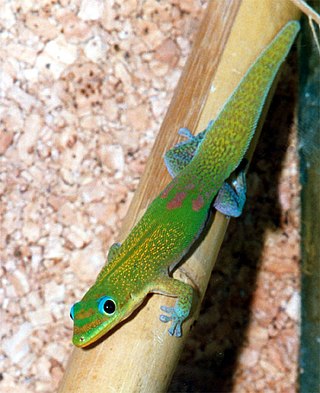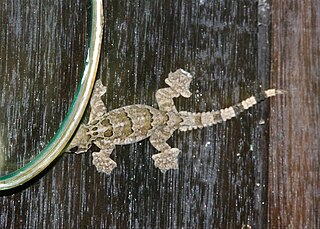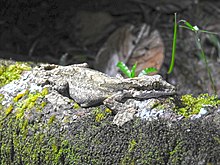
Geckos are small, mostly carnivorous lizards that have a wide distribution, found on every continent except Antarctica. Belonging to the infraorder Gekkota, geckos are found in warm climates throughout the world. They range from 1.6 to 60 centimetres.

Gekkonidae is the largest family of geckos, containing over 950 described species in 62 genera. The Gekkonidae contain many of the most widespread gecko species, including house geckos (Hemidactylus), the tokay gecko (Gekko), day geckos (Phelsuma), the mourning gecko (Lepidodactylus), and dtellas (Gehyra). Gekkonid geckos occur globally and are particularly diverse in tropical areas. Many species of these geckos exhibit an adhering ability to surfaces through Van der Waals forces utilizing intermolecular forces between molecules of their setae and molecules of the surface they are on.

Gekko is a genus of Southeast Asian geckos, commonly known as true geckos or calling geckos, in the family Gekkonidae. Although species such as Gekko gecko are very widespread and common, some species in the same genus have a very small range and are considered rare or endangered.

Geckolepis is a genus of geckos, commonly referred to as fish scale geckos, which are endemic to Madagascar and the Comoro Islands. They are nocturnal, arboreal, insectivorous lizards, found in primary and secondary forest, as well as degraded habitats. They are best known for their ability to lose their skin and scales when grasped by a predator.

Luperosaurus is a genus of lizards, commonly known as camouflage geckos, fringed geckos, wolf geckos, and flap-legged geckos, in the family Gekkonidae. The genus is native to Southeast Asia.

Ptychozoon was a genus of arboreal geckos, endemic to Southeast Asia, known commonly as flying geckos, gliding geckos, or parachute geckos. They all are now placed in the genus Gekko in the family Gekkonidae. The biogeographic history of the genus Ptychozoon was deeply nested within that of the genus Gekko, the center of diversity of which is within Southeast Asia. Since dispersing into Southeast Asian rainforests, Pytochozoon, like other forest-dwelling vertebrates, adapted to facilitate gliding. All species in the genus Ptychozoon are characterized by cryptic coloration and elaborate webs surrounding the neck, limbs, trunk, and tail. These membranes help to conceal the gecko against trees. When the gecko leaps into the air, the flaps are used to generate lift and allow the gecko to control its fall. It can glide up to 200 feet. Also it does a swoop at the end of its glide to land softly. A similar adaptation is found in geckos of the genus Cosymbotus. There were thirteen described species in the genus Ptychozoon.

Heinrich Kuhl was a German naturalist and zoologist.

The tokay gecko is a nocturnal arboreal gecko in the genus Gekko, the true geckos. It is native to Asia and some Pacific Islands.

The flat-tailed house gecko, also known as the frilled house gecko or Asian house gecko, is a species of Gekkonidae native to southeastern and southern Asia. The species is sometimes classified under the genus Cosymbotus.

Gekko lionotum, commonly known as smooth-backed gliding gecko or Burmese flying gecko, is a species of gecko found in Southeast Asia.

Christinus marmoratus, also known as marbled gecko or southern marbled gecko, is a species of Gekkonidae (gecko) native to southern mainland of Australia, from Victoria to Western Australia. The species is well adapted to a variety of habitats, including city dwellings..

The Persian spider gecko hails from semidesert regions of Iran, Pakistan, and Afghanistan, where temperatures range from extreme summer day highs to extreme winter night lows.

Uroplatus sikorae, commonly referred to as the mossy leaf-tailed gecko or the southern flat-tail gecko, is a species of lizard in the family Gekkonidae. The species is endemic to Madagascar. It is a CITES II protected animal due to habitat loss.
The Namib day gecko is a species of lizard in the family Gekkonidae. The species is found in the deserts of Namibia and southern Angola. It is the type species of the genus Rhoptropus.

Grossmann's gecko, also known commonly as the marbled gecko, is a species of lizard in the family Gekkonidae. The species is endemic to Vietnam.
Gekko shibatai is a species of gecko, a lizard in the family Gekkonidae. The species is endemic to the Ryukyu Islands.
Brooks's wolf gecko is a species of lizard in the family Gekkonidae. The species is endemic to Sumatra.

Pak Djoko's flap-legged gecko, also known commonly as Iskandar's wolf gecko, is a species of gecko, a lizard in the family Gekkonidae. The species is endemic to Sulawesi.

Luperosaurus macgregori, known commonly as MacGregor's wolf gecko or McGregor's flapped-legged gecko, is a species of gecko, a lizard in the family Gekkonidae. The species is endemic to the Philippines.

Gekko horsfieldii, also known commonly as Horsfield's flying gecko, Horsfield's gliding gecko, and Horsfield's parachute gecko, is a species of lizard in the family Gekkonidae. The species is endemic to Asia.





















